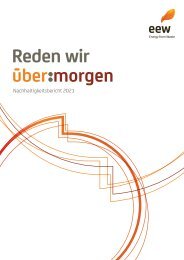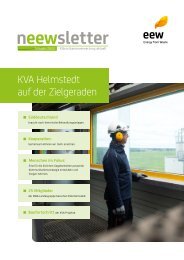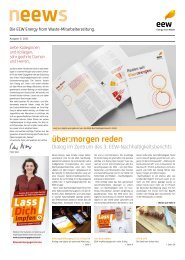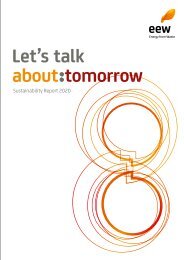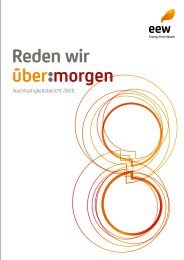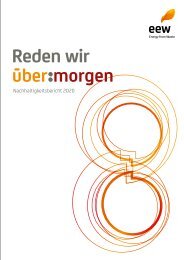Let's talk about tomorrow - Sustainability Report 2021
Create successful ePaper yourself
Turn your PDF publications into a flip-book with our unique Google optimized e-Paper software.
094 | 095<br />
and the rest of the organic matter are bound on carbonbased<br />
adsorbents. Other pollutants such as hydrogen<br />
chloride (HCl) or sulphur oxide and its compounds (SOx)<br />
are bound by adding reagents and then filtered out.<br />
Nitrogen oxides (NOx) are removed from the waste gases<br />
by adding ammonia or ammonium compounds. The<br />
released ammonia reacts with the NOx in the waste gas<br />
to form environmentally neutral components (nitrogen<br />
and water). This means that none of the harmful substances<br />
that are separated out of the flue gas stream<br />
enter the biosphere, which would cause the output to<br />
have a negative environmental impact. What is more,<br />
the remaining emitted pollutant loads – such as heavy<br />
metals and organic hydrocarbons – are lower than<br />
those put in in the form of substitute fuels. None of the<br />
remaining pollutant loads have a harmful effect on<br />
the biosphere in the plants’ emission zones.<br />
pure phosphorus. This means we will be able to substitute<br />
some 1,100 ton nes of raw phosphorus each year<br />
with our Helmstedt operations in the future. We have<br />
already signed a cooperation agreement with Seraplant<br />
GmbH for the further processing of the raw phosphorus.<br />
Seraplant operates one of the first industrial production<br />
facilities to make straight and complex fertilisers containing<br />
phosphate based on sewage sludge ash.<br />
With this partnership, we are working to convert sewage<br />
sludge into fertiliser long before phosphorus recovery<br />
becomes mandatory in 2029. In this way, we are making<br />
a valuable early contribution to environmental and resource<br />
conservation in Germany. We have already been<br />
granted permission to build additional plants in Delfzijl,<br />
Stavenhagen and Magdeburg. Accordingly, we started<br />
constructing facilities in Stavenhagen and Magdeburg<br />
in October <strong>2021</strong>. The licensing procedure is still under<br />
way for another project in Stapelfeld.<br />
Emissions<br />
We check whether the emissions from thermal recovery<br />
conform with the law by conducting continuous measurements<br />
and permanent self-monitoring. To do this, we<br />
use measuring technology certified by the German Technical<br />
Inspection Agency (TÜV) and the German Environment<br />
Agency (UBA), which is inspected and calibrated by<br />
external experts at predetermined intervals. By closely<br />
monitoring flue gas cleaning and the values determined,<br />
we are able to safely comply with the statutory requirements.<br />
We conduct special training to raise our employees’<br />
awareness of safe compliance with limits.<br />
Against this backdrop, we completed a technical inspection<br />
in <strong>2021</strong> to prepare for the revision of the 17th Ordinance<br />
on the Implementation of the Federal Immission<br />
Control Act planned for 2023. The revision is expected to<br />
entail a further reduction in emissions of harmful substances<br />
and tighter limits. We are prepared for the changes<br />
and will make a further reduction in emissions by our<br />
plant fleet.<br />
Thermal recovery uses high temperatures which complet<br />
ely destroy organic pollutants in waste. The resulting<br />
emissions contain carbon monoxide, sulphur dioxide,<br />
hydrogen chloride and nitrogen oxides, ammonia, heavy<br />
metals, mercury and unburnt hydrocarbons. We are<br />
working on reducing these harmful substances as far as<br />
possible using various processes. For instance, some<br />
heavy metals are transferred to the flue gas so that they




